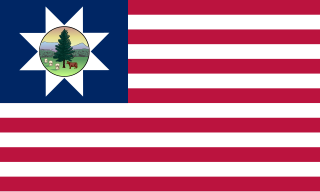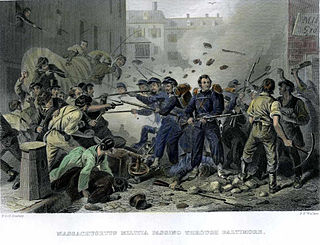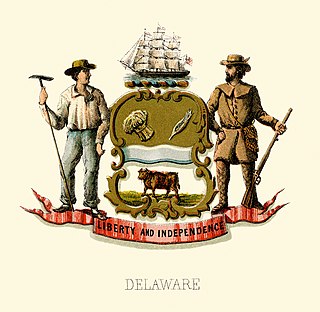
The 12th Vermont Infantry Regiment was a nine months' infantry regiment in the Union Army during the American Civil War. It served in the eastern theater, predominantly in the Defenses of Washington, from October 1862 to July 1863. It was a member of the 2nd Vermont Brigade.
The 6th Minnesota Infantry Regiment was an infantry regiment that fought in the Union Army during the American Civil War. The 6th Minnesota Infantry spent much of the war in the Northwest fighting Dakota Indians rather than participating in the battles with the Confederacy. Led by William Crooks, the regiment saw action in the American Civil War mainly with the Dakota Tribe.

The 6th Wisconsin Infantry Regiment was an infantry regiment that served in the Union Army during the American Civil War. It spent most of the war as a part of the famous Iron Brigade in the Army of the Potomac.
Galvanized Yankees was a term from the American Civil War denoting former Confederate prisoners of war who swore allegiance to the United States and joined the Union Army. Approximately 5,600 former Confederate soldiers enlisted in the United States Volunteers, organized into six regiments of infantry between January 1864 and November 1866. Of those, more than 250 had begun their service as Union soldiers, were captured in battle, then enlisted in prison to join a regiment of the Confederate States Army. They surrendered to Union forces in December 1864 and were held by the United States as deserters, but were saved from prosecution by being enlisted in the 5th and 6th U.S. Volunteers. An additional 800 former Confederates served in volunteer regiments raised by the states, forming ten companies. Four of those companies saw combat in the Western Theater against the Confederate Army, two served on the western frontier, and one became an independent company of U.S. Volunteers, serving in Minnesota.

The 11th Rhode Island Infantry Regiment was a unit of the Union Army during the American Civil War.
The 11th Maryland Volunteer Infantry Regiment was an infantry regiment that served in the Union Army during the American Civil War.
The 1st Maryland Infantry Regiment, Potomac Home Brigade was an infantry regiment that served in the Union Army during the American Civil War.
The 3rd Maryland Infantry Regiment, Potomac Home Brigade was an infantry regiment that served in the Union Army during the American Civil War.
The 159th Ohio Infantry Regiment, sometimes 159th Ohio Volunteer Infantry was an infantry regiment in the Union Army during the American Civil War.
The 84th Ohio Infantry Regiment, sometimes 84th Ohio Volunteer Infantry was an infantry regiment in the Union Army during the American Civil War.
The 197th Ohio Infantry Regiment, sometimes 197th Ohio Volunteer Infantry was an infantry regiment in the Union Army during the American Civil War.

The 6th Regiment New York Heavy Artillery, U.S. Volunteers, the "Anthony Wayne Guard", was an artillery regiment of the Union Army during the American Civil War. It was originally mustered in as the 135th New York Volunteer Infantry Regiment, and served as both artillery and infantry.
The 3rd Delaware Infantry Regiment was an infantry regiment in the Union Army during the American Civil War.
The 5th Maryland Volunteer Infantry Regiment was an infantry regiment that served in the Union Army during the American Civil War.
The 19th United States Colored Infantry was an infantry regiment that served in the Union Army during the American Civil War. The regiment was composed of African American enlisted men, mostly from southern Maryland and that state's Eastern Shore. Commanded by white officers, it was authorized by the Bureau of Colored Troops which was created by the United States War Department on May 22, 1863.

The 6th Regiment Massachusetts Volunteer Militia was a peacetime infantry regiment that was activated for federal service in the Union army for three separate terms during the American Civil War (1861-1865). The regiment gained notoriety as the first unit in the Union Army to suffer fatal casualties in action during the Civil War in the Baltimore Riot and the first militia unit to arrive in Washington D.C., in response to President Abraham Lincoln's initial call for 75,000 troops. Private Luther C. Ladd of the 6th Massachusetts is often referred to as the first Union soldier killed in action during the war.

The 7th Delaware Infantry Regiment was an infantry regiment of the Union Army in the American Civil War. Raised in response to the Confederate cavalry raid into Maryland in mid-1864, the regiment guarded railroad bridges and garrisoned the Baltimore defenses during its month of service.
The 1st Delaware Cavalry Battalion was a cavalry regiment of the Union Army in the American Civil War. Raised in late 1862, the 1st Delaware Cavalry Battalion was initially to be raised as the 1st Delaware Cavalry Regiment, but was reduced to a battalion due to the inability of the state to fill a cavalry regiment to full strength. It served on provost duty in Maryland and Delaware from 1863 to early 1864, and fought in the action at Westminster known as Corbit's Charge during the Gettysburg Campaign. It participated in the Overland Campaign in June 1864, then returned to Maryland after the Confederate cavalry raid of Jubal Early. It remained there for the remainder of the war, and was mustered out after its end.

The 196th Regiment Pennsylvania Volunteer Infantry, alternately the 5th Union League Regiment was an infantry regiment of the Union Army in the American Civil War. Raised in Philadelphia in mid-1864, the regiment was made up of Hundred Days Men in an effort to augment existing manpower for an all-out push to end the war within 100 days, and spent most of its service guarding Confederate prisoners of war at Camp Douglas.

Fort Marshall was a historical American coastal four-point bastion fort located in what is now the Highlandtown and Canton neighborhoods of Baltimore, Maryland. It was built at the outset the American Civil War in 1861, to protect the eastern approaches of Baltimore from Confederate attacks. The fort remained garrisoned for the duration of the war. After 1866, the fort's buildings were salvaged for other purposes and the area ultimately became the site of the Sacred Heart of Jesus Roman Catholic Church, surrounded by the developing residential neighborhoods of southeast Baltimore.








